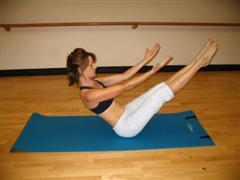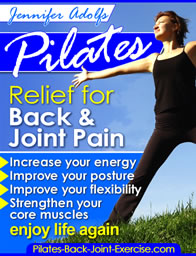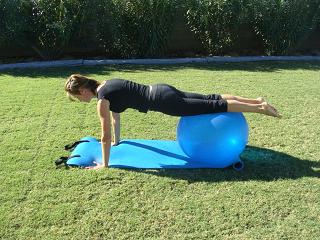Pilates Abdominal Exercises
Pilates abdominal exercises use body alignment and resistance principles to develop strong abs.
Rather than relying on repetitions to build bulky muscles, Pilates strengthens and lengthens muscles to create long, lean and healthy muscles which leads to increased overall body health and conditioning.
A Philosophy for Life
Pilates abdominal exercises form the core group of exercises in the program.
The Pilates program was developed on the principle that a strong core muscle group is required to achieve overall health.
The program incorporates many other essential principles that include concentration and focus, but the strong muscles are formed primarily through body alignment and using the body to create muscle resistance, thus making them work harder.
Pilates is not just an exercise program.
It is virtually a philosophy for life that asks you to take personal responsibility for your health while teaching you how to use the mind in conjunction with the body to achieve desired results.
What you learn through Pilates can be carried over into most all of your life activities.
It helps you move a new grace and ease, better posture and balance, and with more confidence and energy.

The Core of the Matter
A strong body core enables the rest of the body to work more efficiently.
The abdomen muscles connect the upper and lower body. This means their condition has an enormous impact on how well the body is able to move.
When you think about the many tasks you ask your body to handle throughout the day, from carrying bags of groceries to climbing stairs, you can easily understand why strong abdomen muscles are critical.
The Pilates for abs philosophy requires concentration on the muscles you are using as you develop the ability to stabilize the torso.
By maintaining torso stability, the abdomen muscles are engaged to their fullest which leads to faster and better results.
There is no comparison between doing crunches and doing Pilates abdominal exercises, because Pilates is more comprehensive and requires the application of alignment and resistance principles.
The best way to show the difference is by pointing out that many people actually find their leg muscles begin to ache while doing crunches! This is an indication the abdomen muscles are not the primary muscles in use and the effort is begin concentrated on gripping the floor with the legs for stability rather than using stabilized core muscles.
Resisting ‘A Rest’ with Pilates Abdominal Exercises
In traditional strength training programs, resistance is created through the use of weights. But so many people are not getting the full benefit of the resistance training because the body is not in alignment during the moves and/or the connecting muscles are not being challenged.
Repetition using weights can actually create lazy muscles that don’t have to “think” anymore to get the job done.
When using the Pilates core ball you have to recruit all the muscles in the body to stay balanced while performing the exercises.
Pilates abdomen exercises use the resistance of the body itself to develop long and lean muscles. You learn how to force muscles to work harder creating muscle resistance. The powerhouse or core muscle group is more engaged and thus works harder.
Pilates abdominal exercises are some of the most effective results-oriented exercises you can include in your fitness program. You can use the power of concentration to increase muscle resistance leading to results you have not been able to achieve in traditional exercise programs.
In Pilates, your muscles are not given an opportunity to get lazy!
Click Here to Leave Pilates Abdominal Exercises and Return Home
Recent Articles
-
Pilates after Total Knee Replacement
Apr 23, 20 06:20 PM
It's 2 yrs.post op since I had total knee replacement in both knees. In order for them to last it's recommended that you lift not more than 25 lbs. Pilates -
SI Joint Pain Improved with Pilates!
Aug 11, 17 12:29 AM
Dear Jennifer, I just wanted to reach out and thank you for dramatically improving and changing my life. About a year ago, I woke up in debilitating -
Hip pain after 4 months of Reformer Pilates
Jul 12, 17 06:44 PM
Hi, I had a total right hip replacement 8 months ago; I rehabbed really quickly, although I was also (and still am) dealing with L4 spondylolisthesis.
 | Get Instant Access to Loads of Color Pictures, Postures, and Information Designed to Increase Comfort and Happiness. Learn to Enjoy Life Again! Learn More! |


New! Comments
Have your say about what you just read! Leave me a comment in the box below.